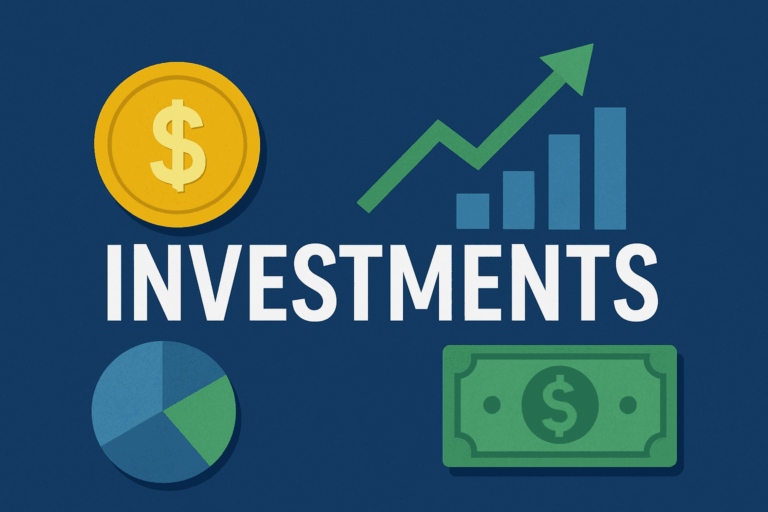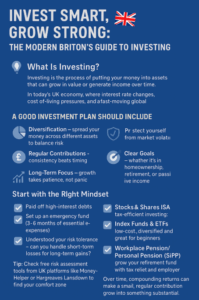
The Only Investment guide You'll Ever Need
Investing has always been a key way to build wealth and attain long-term financial stability. Although there are safety and liquidity factors associated with saving money in a traditional account, gains are generally insignificant and do not keep up with inflation.That’s why people, and business, around the world invest money in the hopes that it will work for you.
So the goal of this guide is to give a bird’s eye view of investments, their significance, forms and strategies, risks involved, and how beginners can leap into the fray.

What Are Investments?
An investment is essentially anything you put money into with the hope that it will produce more money. Unlike savings, which sit idle in a check or savings account, investments plunk money down in things like stocks, bonds, real estate or a business that hold a reasonable chance to increase in value.
Investing isn’t about making a quick buck; it’s about generating durable financial value over time and opening the door to new income streams.
Why Are Investments Important ?
Wealth Building
Investing enables people to build wealth over the long-term, through reinvestment and compounding.
Beating Inflation
Inflation erodes the value of money. By making smart investments, you can help shield and possibly increase real worth long term.
Financial Security
Diversified investments can serve as a safety net at times of uncertainty or in the retirement years.
Achieving Goals
From purchasing a home, to paying for education, and starting a business, investments are often the cornerstone of your path to long-term goals.
Types of Investments
There are different types of investments and each comes with risk and reward characteristic. Here are some of the more common categories:
Stocks
Owning stocks means you own part of the company. Investors who buy shares become co-owners and can profit in the form of dividends (profit share) and the rise in stock price, capital gains. Stocks can be risky, but historically they provide a substantial return over the long term.
Bonds
Bonds are a type of fixed-income investment in which investors lend money to governments or corporations in exchange for interest payments. They tend to be less risky than stocks, which makes them favorites of conservative investors.
Real Estate
Real estate investing is the act of buying real estate in order to make money, whether it be rental income or selling for profit. Real estate is both a source of cash flow and a hedge against inflation.
Mutual Funds and ETFs
Mutual funds are entities that take money from many investors to buy a diversified portfolio of assets managed by professionals. An Exchange-Traded Fund (ETFs) operates in much the same way, but they are traded on stock exchanges like individual stocks. They’re perfect for people who want diversification without the hassles of juggling multiple holdings.
Commodities
Gold, silver, oils and foodstuffs are well-known commodities. Investors frequently look to them to safeguard themselves during times of economic uncertainty, since they can offer stability when markets are otherwise volatile.
Cryptocurrencies
Bitcoin and Ethereum, digital assets that have become popular alternative investments. They are high risk, high reward bets, given price volatility and regulatory ambiguity.
Risk and Reward in Investments
There is an element of risk in every investment. It’s important to understand the risk/reward balance:
(Generally, low-risk investments, such as government bonds, offer stability but lower returns.)
High-stakes investments (like single stocks or cryptocurrencies) have a higher potential return, but also the risk of massive losses.
A reasonably diversified portfolio will have some of each, depending on how risk-averse the investor in question is and what its financial goals are.
Risk and Reward in Investments
- There is an element of risk in every investment. It’s important to understand the risk/reward balance:
- (Generally, low-risk investments, such as government bonds, offer stability but lower returns.)
- High-stakes investments (like single stocks or cryptocurrencies) have a higher potential return, but also the risk of massive losses.
- A reasonably diversified portfolio will have some of each, depending on how risk-averse the investor in question is and what its financial goals are.
How to Start Investing
For novices, taking baby steps that slowly but surely help build their confidence is crucial. Here are the basic steps:
- Define Goals: Ask yourself what you’re investing for: retirement, education, wealth building, financial freedom.
- Assess Risk Tolerance: How much volatility can you tolerate before you panic or rush to sell?
- Create a Budget: First, only invest money after taking care of the bills and an emergency fund.
- Choose a Platform: Global markets are accessible to investors through brokerage firms, robo-advisors, or investment apps. Look at fees, user-friendliness and features before choosing one.
- Start Small: Start with simple things like index funds or ETFs and work your way into the more complicated stuff.
- Keep Learning: Investing is a lifelong process. Continuing education serves to better the decisions and fewer are the mistakes.
Common Mistakes to Avoid
Chasing Quick Profits
Making bad decisions in an effort to get rich quick often ends in disappointment. One should think of investing as a long-term proposition.
Ignoring Fees and Taxes
Unintended costs can chip away at profits. Be sure to review any management fees, trading commissions and tax consequences.
Emotional Decisions
Fear and greed can cause one to buy high and sell low. Simply having a logic driven strategy keeps you from panicking.
Lack of Diversification
Vulnerability grows when you over invest in a single stock or a piece of property or an entire market.
Technology’s Place In Today’s Financial Investing
Today, the technology has revolutionized investing for people. You can tap into global markets, research and automate your investments through online platforms and mobile apps. For better or worse, financial technology is changing the way we manage and invest our money Artificial intelligence, robo-advisors and blockchain technologies have made investing more available than ever.
Sustainable and Ethical Investments
Investment professionals have been increasingly paying attention to ESG (Environmental, Social and Governance) criteria in the past few years. These investments favor corporations which are “green”, socially responsible, and among efficient. They’re motivated not just by profit, but by the notion, too quaint for Wall Street, that they can make a difference for good in the world — and make a profit — simultaneously.
🎯 Final Thoughts
When it comes to investing, it’s not exclusively for the rich and financially privileged. No matter what the income level you’re starting at, it’s entirely possible to begin constructing a better financial future with the right mindset and the right amount of discipline. By familiarizing themselves with various asset classes, auditing risk tolerance and sticking to sound strategies, they can develop lasting wealth and reach their financial objectives.
Remember: the greatest investment tool of all is time. The sooner you begin and the more regularly you contribute, the more you can capitalize on compounding interest and long-term growth.
Our Post


Invest Smart, Grow Strong: The Modern Briton’s Guide to Investing


